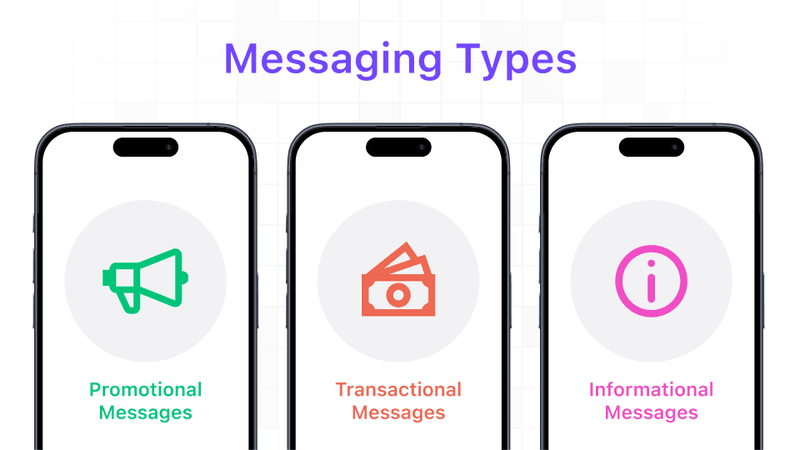What is SMS consent?
SMS consent is the foundation of ethical and legal customer communications. It refers to the explicit permission customers provide to businesses before receiving promotional or transactional messages via text. This consent is crucial not only to comply with legal standards but also to maintain trust and transparency with your customers.

Who sets the rules?
Several key organizations govern the regulation of SMS consent:
Federal Trade Commission (FTC): Enforces rules against deceptive and unfair business practices.
Federal Communications Commission (FCC): Oversees communications via radio, television, wire, satellite, and cable across the United States.
Cellular Telecommunications Industry Association (CTIA): Provides industry guidelines and best practices for wireless communication.
The Legal framework for SMS consent
Key regulations governing SMS consent include the Telephone Consumer Protection Act (TCPA) in the United States, which mandates clear and explicit customer consent before sending promotional messages. This legal framework ensures businesses respect consumer privacy and adhere to ethical marketing practices.
Express written consent requirements
Obtaining explicit written consent is not just a regulatory formality but a cornerstone of trust between a business and its customers. Here are scenarios where it is particularly necessary:
Promotional campaigns: A business must have explicit written consent before sending any promotional SMS, typically through an opt-in message. It is also important to inform subscribers that message and data rates may apply.
Transactional messages: Although transactional messages or SMS, such as order confirmations and appointment reminders, may not always require prior consent, best practice encourages transparency about message frequency and opt-out options.
Best practices for obtaining SMS consent
For businesses to ensure compliance with SMS legal requirements and build a robust and engaged subscriber base, there are a few best practices. Some of them are as belows.
Implementing effective SMS marketing opt-ins is crucial. This includes obtaining explicit consent from customers through various methods such as popup forms, keyword promotions, website landing pages, footer forms, checkbox selections, and mobile QR codes. Utilizing a double opt-in process is essential to ensure compliance and build trust with consumers.
Methods for obtaining consent
Text-to-join campaigns: Encourage customers to send a keyword to a short code, granting consent to receive SMS messages. This method is popular among retailers and event organizers to quickly build a list of engaged subscribers.
Web forms: Embed consent forms on your website, ensuring visitors can easily opt-in to receive SMS communications. Highlight the value they get from signing up, such as exclusive updates or special offers.
In-person sign-ups: Utilize paper forms or digital kiosks at physical locations. Train staff to explain the benefits clearly and ensure the customer’s understanding and consent.
While obtaining consent is super important, it is necessary to be flexible with opt-out options too. Clearly provide opt-out instructions in all consent methods. Use standardized words like 'STOP' and 'CANCEL' to facilitate the opt-out process. Confirm successful unsubscription to maintain compliance and consumer trust.
Advanced consent strategies
Double opt-in: Enhance the accuracy of consent by requiring a confirmation response from the subscriber. This method not only verifies the intent but also protects against accidental sign-ups. Additionally, it ensures that subscribers agree to receive promotional messages, which is crucial for compliance with regulations like the TCPA.
Segmentation and personalization: Use advanced data analytics to segment audiences based on their interests and behaviors. Tailor consent requests to fit the individual’s likely preferences, increasing the chances of obtaining consent.
Regular consent updates: Periodically verify consent with your SMS list to maintain compliance and trust. This practice helps in aligning with evolving regulations and customer expectations.
Content guidelines and prohibitions in SMS marketing
SMS marketing requires adherence to specific content guidelines and legal restrictions to ensure compliance and respect for consumer privacy. Understanding these rules is critical for deploying effective and lawful campaigns.
It is essential to obtain express written consent to send promotional messages that promote products or services, ensuring compliance with TCPA laws and maintaining up-to-date SMS distribution lists.
Understanding SMS consent:- SMS consent is a legal requirement that ensures recipients have knowingly agreed to receive messages from your business. This consent must be clear, informed, and documented, whether obtained through an opt-in message or written agreement.
Importance of clear language:- When requesting SMS consent, the language used should be straightforward and concise, explicitly stating what the recipient is agreeing to. This transparency helps in building trust and complying with legal standards such as the Telephone Consumer Protection Act (TCPA).
Messaging types and their compliance
Differentiating between message types — promotional, transactional, and informational — is crucial as each category has distinct compliance requirements.

Promotional messages: These include advertisements or marketing messages intended to promote a product or service. Promotional text messages typically include sales-related content and require express written consent from consumers before sending, as they are often not critical to the recipient.
Transactional messages: These are messages that contain information the recipient needs, related to ongoing transactions or services, such as appointment reminders or shipping notifications. Consent for transactional messages can be part of the service agreement.
Informational messages: These messages provide valuable information without direct promotional content. Examples include weather alerts or public safety announcements. Depending on context, these may not always require prior consent.
Prohibited content and campaigns
Understanding what content is strictly prohibited is essential for maintaining compliance and protecting your brand’s reputation.
Prohibited content: Content that is illegal, deceptive, or harmful, including hate speech, fraudulent schemes, or adult content, is banned under most SMS regulations. The industry often refers to these as SHAFT categories (Sex, Hate, Alcohol, Firearms, and Tobacco).
Monitoring and enforcement: Regular audits and compliance checks can help ensure that no prohibited content is accidentally sent. It’s vital to stay updated with the changing regulations and industry standards to avoid potential legal issues.
Implementing SMS consent practices
SMS consent involves obtaining permission from individuals before sending them marketing or transactional messages via SMS. This is not just a legal obligation but also a best practice in maintaining transparent communication with your consumers.
Additionally, businesses must ensure that their text messaging practices comply with regulations, which mandates obtaining proper consent and being transparent about the purpose and nature of the messages sent.
Clear and conspicuous notices
Visibility is key: Ensure that your consent notices are prominently displayed, not hidden within fine print. Clear notices inform consumers upfront about what messages they will receive, which can include everything from appointment reminders to promotional offers. This transparency not only complies with regulations like the Telephone Consumer Protection Act but also enhances customer trust.
Simple language: Use straightforward and easily understandable language when detailing the consent agreement. This means avoiding legal jargon that could confuse potential subscribers. For instance, instead of "acquiesce to receive," simply use "agree to receive."
Explicit details: Clearly state what kind of messages the subscribers will receive, whether they are transactional or promotional SMS, and how frequently these messages will be sent. This clarity helps in setting the right expectations and assures the consumer of their control over the communication they are opting into.
Confirming subscription expectations
Immediate confirmation: Send a confirmation message immediately after a user opts in. This not only confirms their subscription but also reinforces the transparency of your SMS program.
A typical confirmation message might read, "Thanks for subscribing to updates from [Your Company]! You'll receive monthly updates on our latest offers. Reply STOP to unsubscribe at any time."
Welcome messages: Following the initial confirmation, send a welcome SMS. This message should thank the subscriber for opting in and provide a brief overview of what they can expect. It's also a good practice to include a contact point for customer service in case they have questions or need assistance.
For example, "Welcome to [Your Company]! We look forward to keeping you updated with the latest news and exclusive offers. Need help? Contact us at [phone number]."
Practical examples and templates for SMS consent
When establishing a framework for SMS consent, businesses must ensure compliance with legal standards while engaging effectively with their audience. It is crucial to obtain consent before sending any promotional or informational text message to ensure compliance with regulations such as the TCPA.
Below, we explore practical examples and customizable templates designed to meet these requirements, especially within sectors like BFSI and logistics.
SMS opt-in examples
Text-to-join: A simple yet effective example for banks could be, "Text 'JOIN' to 12345 to receive updates on your account status and exclusive offers from [Bank Name]." This opt-in method clarifies the consent directly and is easy for customers to understand.
Web form opt-in: For logistics, a web form on a company's website might include a checkbox that users must tick to opt-in, accompanied by text such as, "I agree to receive shipment updates and promotional offers via SMS from [Logistics Company]." This method ensures that consent is explicit and documented.
In both cases, it's crucial to provide clear information on the nature of the messages and how often they will be sent, ensuring transparency and adherence to SMS compliance guidelines.
Customizable Opt-in Templates
For BFSI: A customisable template might look like:
Header: SMS Communication Consent
Body: "I consent to receive automated texts from [Bank Name] regarding my account. I understand that I am not required to provide this consent as a condition of purchasing any goods or services."
Opt-out information: "Reply STOP to unsubscribe at any time."
For Logistics: A similar template could be adapted for logistics needs:
Header: Agreement to Receive SMS Notifications
Body: "I agree to receive text messages from [Logistics Company] regarding order tracking and occasional promotions. Message frequency varies."
Opt-out clause: "Text STOP to cancel."
These templates should be customizable to reflect the specific compliance needs of the business and the preferences of its customers. They must also include an explicit acknowledgment of consent to comply with regulations such as the Telephone Consumer Protection Act (TCPA).
Maintaining compliance over time
As regulations evolve, such as the recent updates to the TCPA to include a new rule referred to as the "one-to-one" consent requirement, it is critical to review and update your consent forms and procedures. This rule requires that consent to receive marketing communications via text must be granted directly and specifically to each individual company, rather than through broad or blanket consent mechanisms.
This includes clarifying consent language and ensuring that your opt-out mechanisms are visible and easy to use.
Stay informed: Regularly review updates from regulatory bodies like the FCC to ensure your practices comply with new rules. For instance, the "one-to-one" consent requirement now mandates that consumers explicitly select which businesses can contact them, a move to enhance consumer control over personal data.
Revise consent forms: Update your SMS consent forms to be clear and unambiguous. This includes providing explicit details about the type of messages consumers are agreeing to receive and ensuring that consent is obtained for each distinct type of communication.
Train your team: Ensure that all team members, especially those involved in direct consumer interactions, are trained on the latest regulations and consent practices. This helps prevent compliance slips and enhances the overall integrity of your consent process.
Handling SMS consent data updates
Managing and updating SMS consent data effectively is crucial to avoid sending messages to those who have opted out or whose preferences have changed. This is particularly important after merging contact lists or when individuals update their consent preferences.
Regular audits: Conduct frequent audits of your consent records to ensure accuracy. Remove outdated or incorrect entries, and update your lists to reflect current consumer preferences.
Clear opt-out options: Provide easy and accessible methods for consumers to withdraw consent. This includes simple SMS keywords like "STOP" and ensuring that opt-out requests are processed promptly.
Confirmation messages: Send confirmation messages to subscribers who update their preferences. This reassures them that their new preferences have been recorded and will be respected.
Conclusion
Ensuring compliance with SMS consent guidelines not only adheres to legal requirements but also reinforces trust with your audience. Incorporating clear opt-in processes, regularly conducting compliance reviews, and leveraging platforms like Fyno for secure, customisable messaging solutions can enhance customer engagement and maintain robust data protection.
FAQs
1. What is SMS consent, and why is it important?
SMS consent is the explicit permission a customer gives to receive text messages from a business. It is crucial because it ensures legal compliance and builds trust between the business and its customers.
2. Who regulates SMS consent?
SMS consent is regulated by organizations like the Federal Trade Commission (FTC), Federal Communications Commission (FCC), and Cellular Telecommunications Industry Association (CTIA), which set the rules for ethical and legal communication practices.
3. What are the legal requirements for obtaining SMS consent?
The Telephone Consumer Protection Act (TCPA) in the United States mandates that businesses must obtain clear and explicit consent from customers before sending promotional SMS messages.
4. When is express written consent required?
Express written consent is required for sending promotional SMS messages, ensuring that customers knowingly agree to receive such communications. Transactional messages may not always require prior consent but should still be transparent.
5. What are some best practices for obtaining SMS consent?
Best practices include using clear opt-in methods like text-to-join campaigns, web forms, and in-person sign-ups, along with implementing a double opt-in process to verify consent.
6. How can businesses ensure compliance with SMS consent regulations?
Businesses can ensure compliance by using clear and conspicuous notices, obtaining explicit written consent, offering easy opt-out options, and regularly updating consent data.
7. What should be included in an SMS opt-in confirmation message?
An SMS opt-in confirmation message should thank the customer for subscribing, briefly outline what types of messages they will receive, and provide clear instructions on how to opt out if they choose to do so.


